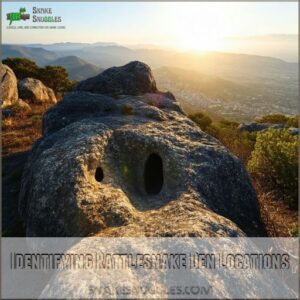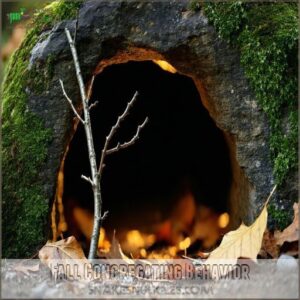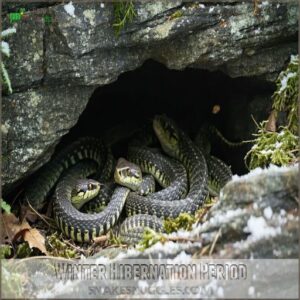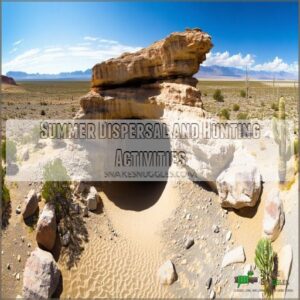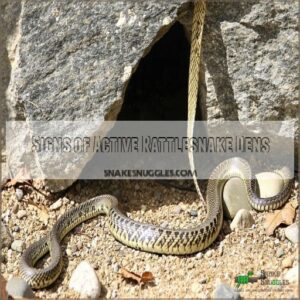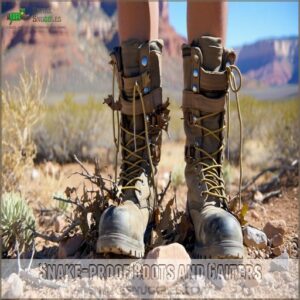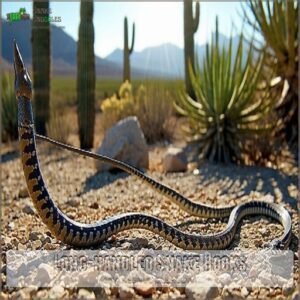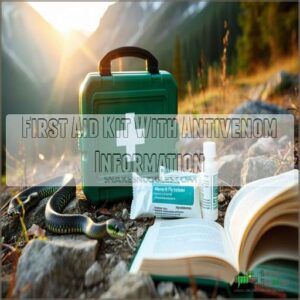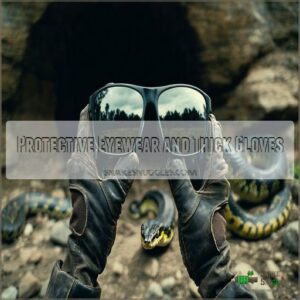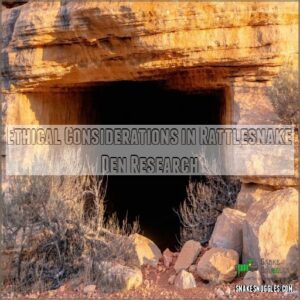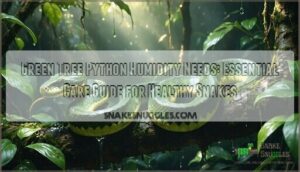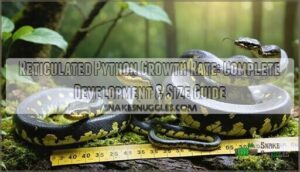This site is supported by our readers. We may earn a commission, at no cost to you, if you purchase through links.
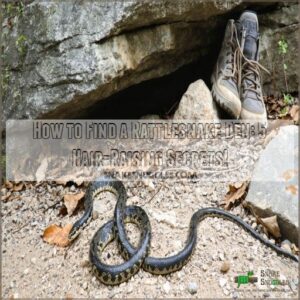 Want to find a rattlesnake den? Look for rocky outcrops, abandoned animal burrows, and south-facing slopes with natural cover.
Want to find a rattlesnake den? Look for rocky outcrops, abandoned animal burrows, and south-facing slopes with natural cover.
Check for telltale signs like shed snake skins, a musky odor, and visible tracks in soft soil.
Spring and fall are prime times to spot these elusive serpent sanctuaries, when snakes emerge from or congregate around their winter hideouts.
Always wear snake-proof boots, carry a long-handled snake hook, and move cautiously. Remember, you’re entering their territory, so respect the habitat and keep a safe distance.
Curiosity might have you on the edge of your seat, wondering what secrets these serpentine homes might reveal next.
Table Of Contents
- Key Takeaways
- Identifying Rattlesnake Den Locations
- Seasonal Timing for Rattlesnake Den Discovery
- Signs of Active Rattlesnake Dens
- Essential Safety Gear for Den Exploration
- Ethical Considerations in Rattlesnake Den Research
- Frequently Asked Questions (FAQs)
- Are Rattlesnake Dens Dangerous?
- What Time of Year Are Rattlesnake Dens Most Active?
- Are There Any Natural Repellents That Can Be Used to Keep Rattlesnakes Away?
- Is It Legal to Kill a Rattlesnake?
- How Can I Tell if There Are Rattlesnakes Around My Home?
- How far will rattlesnakes travel from their den?
- How do you identify a snake den?
- How many rattlesnakes are usually in a den?
- How do you know if a rattlesnake is near?
- What role do rattlesnake dens play in reproduction?
- Conclusion
Key Takeaways
- You’ll want to scout rocky outcrops, abandoned animal burrows, and south-facing slopes with natural cover, as these are prime real estate for rattlesnake dens.
- Always gear up with essential safety equipment, such as snake-proof boots, long-handled snake hooks, and a first aid kit, before exploring potential den locations.
- You’ll find that the best times to locate rattlesnake dens are during spring emergence and fall congregations, when snakes are most active and gathering in specific areas.
- Remember to approach den exploration ethically by minimizing habitat disturbance, documenting carefully, and prioritizing both your safety and the snakes’ ecological importance.
Identifying Rattlesnake Den Locations
If you’re wondering where rattlesnakes hide, understanding their preferred habitats can help you spot potential den locations with scientific precision.
You’ll want to look for rocky outcrops, abandoned animal burrows, and south-facing slopes that provide these elusive reptiles with the perfect combination of shelter, warmth, and protection.
Natural Rock Formations and Crevices
Frequently, rocky landscapes hide nature’s most cunning predators. Rattlesnakes transform limestone, granite, and sandstone formations into secret sanctuaries, seeking out 2-3 inch crevices that promise protection and perfect temperature control.
- Rock formations offer natural camouflage and temperature regulation
- Cracks provide strategic shelter from predators and environmental extremes
- Geological diversity determines ideal snake habitats
Your keen eye can reveal these serpentine hideouts, where survival meets geological precision.
Abandoned Animal Burrows
Ever wondered how rattlesnakes score prime real estate?
These opportunistic hunters hijack abandoned burrows like seasoned squatters. Prairie dog tunnels, ground squirrel homes, and old fox dens become snake sanctuaries faster than you can say "new landlord."
Nature’s resourceful reptiles transform these ready-made hideouts into perfect shelters, escaping scorching heat and staying hidden from predators.
They effectively create their own snake sanctuaries.
Hollow Logs and Fallen Trees
Slithering from abandoned burrows, rattlesnakes find sanctuary in hollow logs and fallen trees.
These wooden havens offer more than just shelter – they’re prime real estate for these cunning reptiles.
To identify potential rattlesnake den locations, look for larger decaying logs with soft interiors.
Larger decaying logs with soft interiors become snake condominiums, especially when insects buzz nearby, creating a tempting all-you-can-eat buffet for these master predators.
South-facing Slopes for Optimal Sun Exposure
The sun-drenched south-facing slopes serve as nature’s ultimate reptile retreat for rattlesnakes.
These strategic terrain features offer more than just a warm hangout—they’re essential survival zones where snakes regulate body temperature and scout for prey.
To increase your chances of finding a rattlesnake den, consider utilizing specialized tools and products for rattlesnake den detection.
Rocky outcrops with sparse vegetation create perfect sunbathing platforms that transform cold-blooded hunters into efficient predators.
Proximity to Water Sources
Hunting for a rattlesnake den near water? You’re in luck! These slick predators aren’t just hanging out randomly – they’re strategic about their hydration spots. Water sources act like snake magnets, drawing them in during different seasons.
Picture this: In spring, creeks become high-priority watering holes. Summer shifts the action to ponds, while fall sees snakes less in aquatic hangouts. These aren’t just random puddles – they’re survival stations where rattlesnakes quench their thirst and scout for prey.
When mapping potential den locations, keep your eyes peeled for:
- Creek banks with rocky hiding spots
- Pond edges with dense vegetation
- Natural water seeps in rocky terrain
Pro tip: Water sources near south-facing slopes? That’s the snake jackpot. You’re looking at prime real estate for these scaly survivors.
Just remember – approach with caution. These watery territories are rattlesnake comfort zones, and they won’t appreciate unexpected visitors.
Seasonal Timing for Rattlesnake Den Discovery
Understanding the seasonal patterns of rattlesnakes can make your den discovery mission more successful, so you’ll want to time your exploration carefully.
You’ll find that each season brings unique behaviors and challenges, from spring emergence to winter hibernation, which can dramatically impact your chances of locating these elusive reptilian hideouts.
Spring Emergence Patterns
A rattlesnake’s springtime awakening reveals nature’s survival dance.
When temperatures climb above 60°F, these cold-blooded creatures emerge from winter’s tight hibernation spaces, stretching into sunlight-warmed territories.
Watch for subtle movements near rocky outcrops and abandoned burrows.
Their sluggish initial movements make spring the prime time for observing these fascinating reptiles’ seasonal shift from dormancy to active hunting, a true display of nature’s survival dance in the wild during the prime time.
Fall Congregating Behavior
Rattlesnake fall congregations orchestrate a mesmerizing survival symphony, transforming den sites into complex social networks. As temperatures drop, these serpentine communities converge with calculated precision, establishing intricate social hierarchies and preparing for the challenging winter ahead.
For enthusiasts looking to track and locate these hidden dens, specialized gear and tools can be found at Rattlesnake Den Gear. Key congregation dynamics include:
- Strategic den selection near prime thermal refuges
- Establishing complex mating and dominance hierarchies
- Maximizing reproductive opportunities before winter’s onset
During these fall rendezvous, snakes engage in:
- Pheromone-driven mate selection
- Social positioning within the group
- Preparation for winter hibernation
Nature’s masterful adaptation shines through these carefully choreographed gatherings, ensuring species survival through strategic social behavior and reproductive planning.
Winter Hibernation Period
During the long winter months, your cold-blooded friends slip into a fascinating state of winter survival called brumation. Deep inside rocky crevices or underground burrows, rattlesnakes enter a unique physiological slowdown that keeps them alive through the coldest weeks.
Here’s what makes their winter strategy so remarkable:
- Metabolic Miracle: Their body temperature drops dramatically, reducing energy consumption to near-zero levels.
- Hydration Heroes: Unlike mammals, they stay minimally active, occasionally drinking water to prevent dehydration.
- Communal Comfort: Multiple rattlesnakes often share the same den, huddling together for warmth and protection.
- Strategic Shelter: They choose locations that remain just above freezing, typically underground or in deep rock formations.
These serpents aren’t just sleeping – they’re masterfully conserving energy, waiting for spring’s warm embrace to reawaken their hunting instincts. Their brumation is a powerful proof of nature’s incredible survival strategies, turning potential winter death into a calculated pause.
Summer Dispersal and Hunting Activities
As scorching summer heat rolls in, you’ll watch rattlesnakes transform into strategic hunters.
They’re masters of survival, slithering through grasslands and rocky terrains in search of prey.
These cold-blooded predators disperse widely, tracking small mammals and adapting to extreme temperatures with remarkable precision.
Each movement is calculated, each hunt a delicate dance of survival.
They are highly efficient and skilled in their hunting techniques.
Signs of Active Rattlesnake Dens
When hunting for rattlesnake dens, you’ll want to keep your senses sharp and look for telltale signs of serpentine activity around potential hideouts.
Watch for shed snake skins, detect musky odors, spot distinctive tracks in soft soil, listen for warning rattles, and scan for basking snakes near rocky crevices or hidden openings.
Shed Skins Near Den Entrances
snake tracking’s forgotten whisper of snake life lies scattered near den entrances: shed skins. These translucent, paper-thin remnants are nature’s silent storytellers, revealing hidden snake populations.
Look closely for:
- Intact scale patterns
- Distinctive head coverings
- Size variations indicating snake generations
Each discarded skin is a clue waiting to be deciphered by the keen-eyed explorer.
Distinctive Musky Odor
Your nose might be your secret weapon in snake hunting!
Rattlesnake dens carry a distinctive musky odor that screams "snake territory". Think of it like nature’s own GPS – a pungent, unmistakable scent that marks their hidden homes.
The stronger the smell, the closer you’re to their secret hideout.
Snake hunters learn to trust their olfactory instincts.
Visible Snake Tracks in Loose Soil
Decode the serpentine mystery lurking beneath your feet. Rattlesnake tracks are nature’s secret roadmap, revealing hidden dens in the wilderness.
To enhance your tracking skills, consider investing in a rattlesnake tracking kit for easier identification of patterns.
Look for S-shaped patterns stretching across loose soil, with track widths ranging from delicate pencil lines to bold thumb-width impressions. These subtle ground signatures tell a story of slithering movement, guiding keen observers to potential rattlesnake hideouts.
Rattling Sounds From Within The Den
Listen closely, and you’ll hear the telltale warning—a rattlesnake’s signature sound echoing from deep within its den.
These vibration-rich communications reveal more than just a defensive mechanism; they’re a complex language of territory and proximity.
Sharp-eared researchers can detect these distinctive rattling frequencies, which often signal multiple snakes congregating in a single underground sanctuary, a true underground sanctuary.
Basking Snakes Near Den Openings
Serpent sunbathing isn’t just a lazy pastime—it’s a survival strategy. When temperatures rise, rattlesnakes emerge near their rocky sanctuaries, transforming into living solar panels. These scaly strategists position themselves carefully at den entrances, soaking up key warmth that powers their metabolism and hunting capabilities.
Scientists have uncovered fascinating insights into this behavior. Pregnant females, in particular, seek out specific sunlit spots to regulate their body temperature, sometimes traveling impressive distances from their dens. By basking strategically, they optimize embryo development and prepare for the challenges of reproduction.
Watch for telltale signs: a snake stretched out on a sun-warmed rock, perfectly positioned near a crevice or rocky outcropping. Their positioning is deliberate—maximizing heat absorption while maintaining a quick escape route. It’s nature’s perfect balance of thermoregulation and self-preservation.
But don’t get too close. These masters of camouflage can blend seamlessly with their rocky surroundings, ready to retreat at a moment’s notice. Respect their space, and you’ll witness a remarkable display of survival instincts in action.
Essential Safety Gear for Den Exploration
When exploring rattlesnake habitats, you’ll want to gear up with protective equipment that shields you from potential snake encounters.
Your safety arsenal should include snake-proof boots, long-handled hooks, thick gloves, and a first aid kit stocked with critical antivenom information.
Snake-proof Boots and Gaiters
When exploring rattlesnake territories, choose your boots like your life depends on it—because it just might.
Three fundamental layers of protection stand between you and potential fangs: puncture-resistant leather, reinforced ankle guards, and snake-proof gaiters.
Your footwear isn’t just clothing; it’s your first line of defense in unforgiving wilderness where every step could surprise you.
Long-handled Snake Hooks
After protecting your feet with snake-proof boots, grab a long-handled snake hook — your new best friend in rattlesnake territory.
Your hook is more than a tool; it’s your safety lifeline. Here’s why you’ll love it:
- Control from a distance: Keep 3-4 feet between you and potential danger
- Precision movement: Gently redirect snakes without direct contact
- Confidence booster: Feel like a pro wildlife handler
Lightweight aluminum hooks become your ultimate snake-exploration companion.
First Aid Kit With Antivenom Information
Your first aid kit is your lifeline in rattlesnake territory. Pack it with precision, focusing on survival essentials that could mean the difference between life and death. Include an extensive list of nearby hospitals with antivenom capabilities, detailed administration protocols, and emergency contact numbers for poison control. This isn’t just a medical kit – it’s your shield against nature’s most dangerous predators.
Key must-haves:
- Updated hospital antivenom lists
- Detailed treatment instructions
- Emergency contact information for poison control
Remember, when facing a rattlesnake bite, your preparation can be the ultimate game-changer. Stay calm, act fast, and let your well-stocked first aid kit be your tactical advantage in the wilderness.
GPS Device for Location Tracking
Rattlesnake hunters, your GPS is your ultimate wilderness wingman! Modern satellite technology transforms your snake-tracking mission from guesswork to precision mapping.
With high-tech GPS devices, you’ll mark waypoints like a pro, tracking every twist and turn through snake territory. Imagine pinpointing exact den locations with sub-meter accuracy – no more wandering blindly through rocky landscapes!
Key GPS features to rock your expedition:
| Feature | Importance | Field Performance |
|---|---|---|
| Accuracy | Mission-Critical | Sub-meter precision |
| Battery Life | Survival Gear | 20+ hours continuous tracking |
| Terrain Mapping | Game-Changer | Topographic overlays |
Pro tip: Choose a rugged GPS that can handle scorching deserts and rough terrain. Your digital partner isn’t just a location tracker – it’s your silent partner in wildlife exploration, keeping you safe and on target while hunting those elusive rattlesnake hideouts.
Protective Eyewear and Thick Gloves
When exploring rattlesnake territories, your protective gear becomes your lifeline. Imagine facing a venomous encounter without the right equipment – it’s like walking into a lion’s den wearing a meat suit!
Here’s your must-have safety arsenal for snake den exploration:
- High-impact protective eyewear with wraparound coverage
- Puncture-resistant leather gloves extending past wrists
- Snake-proof gaiters protecting lower legs
- Thick-soled boots with ankle support
- Lightweight, breathable protective layers
Stay sharp, stay protected.
Ethical Considerations in Rattlesnake Den Research
When you’re researching rattlesnake dens, you’ll need to balance your curiosity with respect for these critical ecological habitats.
Your goal should be to observe and document without causing unnecessary disruption to these sensitive snake environments.
Minimizing Habitat Disturbance
Wilderness whispers secrets to those who listen carefully.
Tread like a ghost through rattlesnake territories, minimizing your ecological footprint with surgical precision. Every step matters when exploring delicate snake habitats.
Respect transforms observation into conservation.
Stick to established trails, avoid vegetation disruption, and move with calculated slowness. Your presence should be as subtle as a passing breeze.
Proper Photography and Observation Techniques
Camera in hand, you’re ready to capture nature’s most misunderstood predators without causing harm. Your telephoto lens becomes a bridge between observation and respect, letting you document snake behavior from a safe distance.
Pro tips for ethical snake photography:
- Keep your distance: Use a lens that lets you zoom in without intrusion
- Avoid flash photography: It can stress and disorient snakes
- Limit observation time: Stick to 15 minutes max
- Blend into the landscape: Wear neutral, earth-toned clothing
Your goal? Stunning images that tell a story without disturbing the snake’s world.
Reporting Findings to Conservation Authorities
After pinpointing a rattlesnake den, your scientific contribution can be groundbreaking. Conservation authorities are hungry for precise ecological data, especially regarding rattlesnake denning habits.
Here’s how to report strategically:
- Document GPS coordinates with scientific precision
- Capture high-resolution environmental context photographs
- Contact local wildlife management through official Data Sharing Platforms
Your careful observations could reveal critical insights into regional rattlesnake populations and conservation status.
Educating Others About Rattlesnake Ecology
When you’re out exploring the wilderness, you’ve got a golden opportunity to become a snake ambassador. Rattlesnakes aren’t just scary creatures—they’re essential players in desert ecosystems, keeping rodent populations in check and maintaining nature’s delicate balance.
Want to make a real difference? Start by busting snake myths wherever you go. Share how these misunderstood predators play a key role in wildlife conservation. Got a friend who’s terrified of snakes? Show them the science behind snake behavior and their ecological importance.
Think of yourself as a snake whisperer with a mission. Spread the word about herpetology research through casual conversations, social media posts, or even local wildlife education programs. Every time you explain how rattlesnakes help control pest populations, you’re protecting both wildlife and human communities.
Imagine turning fear into fascination. When people understand that these remarkable creatures are more interested in avoiding humans than attacking, you’ll help create a safer, more informed relationship between people and rattlesnakes. Your knowledge can transform perception, one conversation at a time.
Respecting Local Laws and Regulations
Every snake hunter needs a legal compass. Before tracking rattlesnake dens, dig into local regulations like a detective.
State laws can be a minefield of permit requirements and land access restrictions. One wrong step could land you in hot water with fines or trespassing charges.
Always check land ownership, respect conservation zones, and prioritize both your safety and the snakes’ protection.
Frequently Asked Questions (FAQs)
Are Rattlesnake Dens Dangerous?
Rattlesnake dens can harbor dozens of venomous snakes, posing significant risks if accidentally disturbed.
Stay alert, maintain distance, and never attempt to investigate or interact with these potentially dangerous nest sites without professional guidance.
Stay alert, maintain distance, and never attempt to investigate or interact with these potentially dangerous nest sites without professional guidance.
What Time of Year Are Rattlesnake Dens Most Active?
Spring and early summer are your prime times for rattlesnake den activity.
They’ll emerge from hibernation, seeking warmth and hunting prey.
Temperatures between 70-85°F trigger most snake movement, making these months especially active for these fascinating reptiles.
Are There Any Natural Repellents That Can Be Used to Keep Rattlesnakes Away?
Natural oils like cinnamon, clove, and cedar can act as snake deterrents, creating an invisible barrier around your property.
You’ll want to spread these strategically, creating a protective perimeter that makes snakes think twice about crossing.
Is It Legal to Kill a Rattlesnake?
The legality of killing a rattlesnake varies by state.
You’ll want to check local wildlife regulations.
Generally, you can defend yourself if threatened, but randomly killing snakes without cause isn’t recommended or legal in many areas.
How Can I Tell if There Are Rattlesnakes Around My Home?
Look out for coiled snakes near rocks, logs, and burrows—especially on sunny slopes.
Listen for telltale rattles, watch for shed skins, and check potential hiding spots.
Like wood piles, abandoned animal holes, and foundation cracks around your property.
How far will rattlesnakes travel from their den?
Depending on their habitat, rattlesnakes typically roam 1-3 miles from their den during active seasons, with males traveling farther during mating periods to seek potential mates and hunt for food.
How do you identify a snake den?
Slithering secrets reveal themselves in rocky crevices, abandoned burrows, and log piles.
You’ll spot a snake den by looking for 2-3 inch openings near south-facing slopes, with signs of snake activity like shed skins or tracks.
How many rattlesnakes are usually in a den?
A single rattlesnake den can house anywhere from 5 to 25 snakes, though some massive communal dens might shelter hundreds during winter hibernation.
Rocky areas and underground burrows often become crowded snake shelters during cold months.
How do you know if a rattlesnake is near?
You’ll spot rattlesnake warning signs like sudden animal silence, shed snake skins, distinct musky odor, tracks in dust, or droppings near rocky areas.
Stay alert in their habitat, watching for subtle environmental changes that signal a snake’s nearby presence.
What role do rattlesnake dens play in reproduction?
Rattlesnake dens serve as critical mating sanctuaries where females give birth and protect vulnerable newborns.
These underground havens provide a safe, temperature-controlled environment for reproduction and nurturing young snakes during their most fragile stage.
Conclusion
Like a treasure map leading to nature’s most spine-tingling secret, finding a rattlesnake den requires patience, respect, and careful observation.
You’ll reveal the mysteries of these fascinating creatures by understanding their habitat preferences and seasonal behaviors.
When searching for a rattlesnake den, always prioritize safety, minimize environmental disruption, and approach with scientific curiosity.
Remember, your goal isn’t just discovery—it’s contributing to our understanding of these remarkable reptiles and their complex ecosystems, driven by scientific curiosity.

